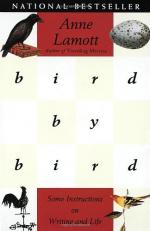
|
| Name: _________________________ | Period: ___________________ |
This test consists of 5 multiple choice questions, 5 short answer questions, and 10 short essay questions.
Multiple Choice Questions
1. What do most of Anne's students assume about why well-respected writers's books turn out beautifully?
(a) They are subject matter experts.
(b) They have outlined the plot.
(c) They analyze each character.
(d) They drink wine.
2. In Anne's experience, and the experience of other writer's she knows, how easily does plot structure come?
(a) Not easily at all.
(b) Easy as pie.
(c) It is like a Gulf stream going through a straw.
(d) It tends to come like the development of a Polaroid.
3. Paying attention is a powerful antidote for what?
(a) Paranoia.
(b) A hangover.
(c) The rational mind.
(d) Sleepless nights.
4. When Anne showed up at the Special Olympics to write an article, did she know what she was going to write?
(a) No, she was not even very interested.
(b) Yes, about a girl on crutches.
(c) She had no idea of what the finished article would be.
(d) Yes, she was going to write a food review about the hot dogs there.
5. Why does Anne write?
(a) She is a good typist.
(b) Her father was a writer.
(c) She wants to and she is good at it.
(d) She has read C. S. Lewis.
Short Answer Questions
1. What does Anne say must first happen before we can recognize others for who they are?
2. What is a recurring problem that Anne sees in her students?
3. What is the question Anne's students always ask?
4. When you start think there is one more thing you could do, what should you remind yourself?
5. How does a writer end up with a good second draft or a terrific third draft?
Short Essay Questions
1. According to Anne, how are we able to see the underlying essence of a person?
2. Plot is the main part of your story. How does the plot best grow organically, according to Anne?
3. How does Anne suggest we can free ourselves from perfectionism?
4. How do you know when you are done, according to Anne?
5. What does a bad first draft provide a writer, according to Anne?
6. Another of Anne's stories stems from the movie Stripes. The line is "Hey, lighten up Francis." How is this story helpful to her students?
7. How did having a mother and father who read, and a father who was a writer, affect Anne's life?
8. How does Anne suggest writers offer hope to readers?
9. When Anne was writing food reviews, how did allowing herself to write bad first drafts help her?
10. In Part 2, The Writing Frame of Mind, Section 1, Looking Around, what is writing about, and how do we see the writer?
|
This section contains 981 words (approx. 4 pages at 300 words per page) |

|




